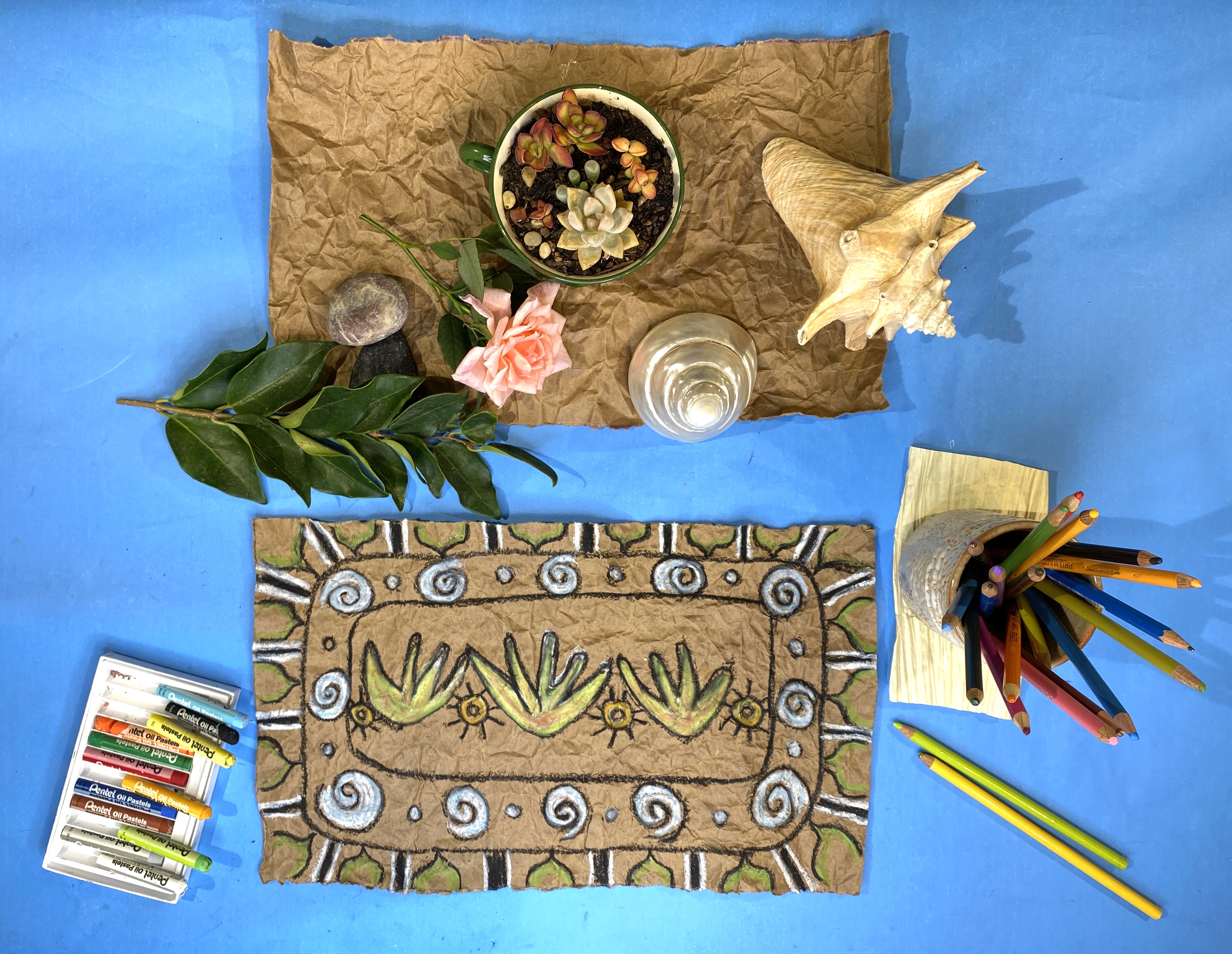Masi, also known as barkcloth, is a textile made by women in Fiji using bark fibers. An important and traditional art form, Fijian masi is famous for its beautiful craftwork and designs. Today, masi ranges in size from a place mat to the length of a long wall! It can be used for ceremonial presentations like weddings or for clothing, and even as a room divider, kind of like a screen.
Making masi is hard work! First the inner bark is removed from the paper mulberry tree. The bark strips are soaked in water for a few days until they are soft. Using a masi beater, which looks like a wooden club, the artists beat the strips until the fibers spread out and resemble a piece of cloth. Then the edges of the smaller pieces of cloth are overlapped and felted or glued until the masi is the desired size.
The final step is to decorate! While some types of masi are left plain, others are covered in elaborate patterns or motifs inspired by the natural environment. Fiji is made up of many islands in the Pacific so shells, the sea, or native plants, abstracted into geometric shapes, are common motifs. There is usually a story or significance behind the pattern and/or composition, but many motifs are highly protected in Fiji, requiring a masi maker from the area to tell the story of a particular motif. In villages, masi traditions and patterns are passed down through the generations. Artists who move out of their village often continue to make masi, bringing their traditions and patterns with them.
The paint or dye used to decorate the masi is made from the juice of the mangrove tree's bark. To make black paint, the soot of burned candlenut fruit is added to the mangrove juice. To make red or brown paint, red clay from the earth is added. Mangrove trees and candlenut trees grow in Fiji. The patterns and motifs are painted free hand, stenciled, or stamped on to the masi with these natural dyes.
Fijian artists make masi using materials they have on hand and inspiration from their natural environment. You and your family can make a masi-inspired work of art using materials you have at home inspired by your environment too!
Let's take inspiration from this masi in LACMA's collection. It's over 12 feet long and four feet wide!

Spend a minute or two looking at this work of art.
- What do you notice?
- How many patterns do you see?
- Can you imagine plants, trees, and flowers in this work of art?
Let's Get Started!
Take a nature walk around your home or neighborhood. If you can (with an adult) take a sketch pad and a camera on your walk to record the patterns and designs you find. If you have indoor plants, you can study them for inspiration too.
Draw an outline of a leaf, a twig, a flower, or anything you see that you really like. Notice what kind of patterns you can find in nature. Say, for example, a leaf. Look closely and you will find a strong line or vein that moves from the bottom of the leaf to the top with smaller veins branching off, creating a symmetrical pattern. Your observations and discoveries will inspire the designs for your artwork.
Supplies:
- Brown paper grocery bag
- Water
- Spray bottle or paper towels or both
- Colored pencils, oil pastels, or crayons
- Paper for sketching
- Scissors
- Smooth stone, or a large spoon
- Butter knife
Steps to transform the paper bag:
- Remove the handles from the grocery bag.

- Cut along the side folds and cut out the bottom along the folds. Cut down the center fold on each side, open the bag, and flatten it.
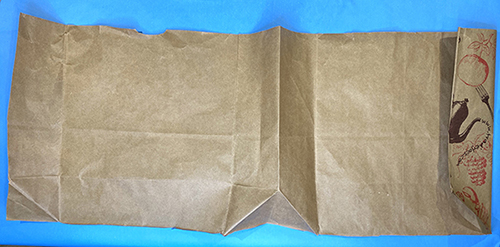
- Cut a large rectangle of any size.
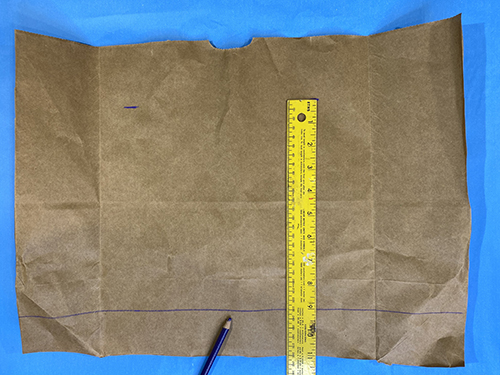
- Tear the edges to make them look ragged. For a controlled tear, fold the edges and score the fold with a butter knife. Fold back and forth a few times.
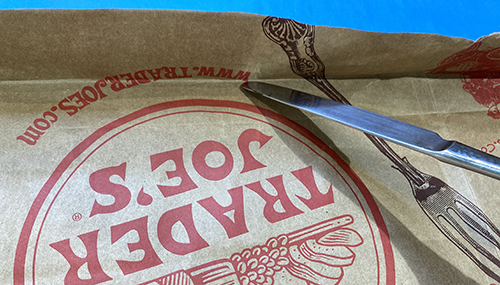
- Wet the folds with a spray bottle or wet paper towels. Tear along the folds.

- Spray the bag with water. Crunch and scrunch the wet paper bag into a ball. Knead it tight for a few minutes. Make sure the paper has a lot of wrinkles.
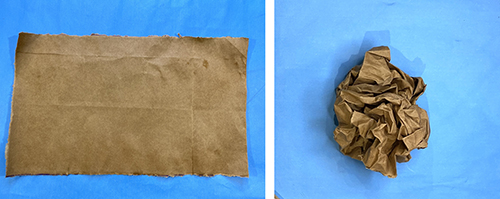
- Open your paper and flatten it with a smooth stone by pressing the rock down hard on the paper. If you don’t have a stone, you can use something smooth and hard like a large spoon. Notice how the surface of the paper bag has changed. All your scrunching and wrinkling gave it a beautiful texture!

- While your paper is drying, think about what designs and patterns you will draw.
- Take a look at your sketches, photos, or pieces of nature that you collected. Which ones do you like the most?

- Take another look at the masi from LACMA’s collection. Notice how the same shapes and lines repeat over and over? This is how you make a pattern—you repeat a series of images, shapes, or colors again and again. Triangle square circle triangle square circle is a pattern. Leaf, flower, flower, leaf, flower, flower leaf is a pattern. Blue, orange, pink, orange, blue, pink is a pattern!
- Is your paper dry yet? If so, then it's time to draw!
- Find the center of your paper and draw a special design in the middle, thinking about your nature discoveries. You can draw in pencil, and go over your design with oil pastels, crayons, or colored pencils—or you can skip the pencil and just go for it! Draw a rectangle around your special design like a frame.
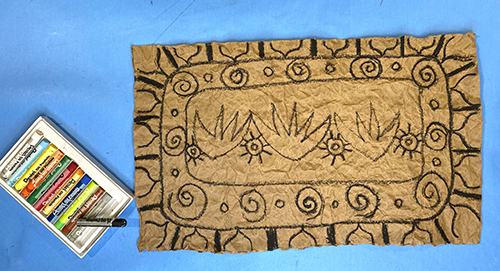
- Now for your pattern... What natural elements will you use in your pattern? Maybe you’ll repeat the shape of a leaf you love, or flower petals you found, or a combination of both! Your pattern can wrap around the rectangle or it can stretch across the page in one long row. Fill your entire paper with different patterns.
Once your page is filled with your nature designs, you are done. Your masi-inspired work is beautiful!
Fijians have always considered the sacredness of nature, and thanked nature for what was used. Take a moment to reflect on what you made today. Did a family member help you or did you help a family member?
Want to learn more about art from Fiji?
In celebration of the Fiji: Art & Life in the Pacific exhibition, Andell Family Sundays @ Home has dedicated the month of September to art from Fiji.
View a dance performance by VOU Fiji on LACMA’s YouTube channel.
Check out a blog about gift-giving in Fiji.
Join us on Sunday, September 27 for a video workshop with contemporary Fijian artist Lambert Ho as he shows us how to make a garland.
Unless noted, all photos taken by Eszter Delgado.





